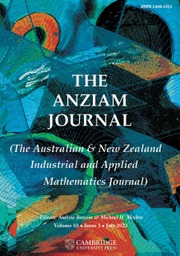This issue of the ANZIAM Journal is dedicated to Emeritus Professor Anthony Roberts of the University of Adelaide. Anthony (or Tony, as most of us know him) has made a significant contribution to the ANZIAM Journal, both as a long-time editor and a prolific author. In 1997, he was the founding editor of the Electronic Supplement of the ANZIAM Journal, at a time when there were very few online journals, and he remained in this position until 2022. In this role, he oversaw the publication of the Proceedings of the Mathematics in Industry Study Group (MISG), the Proceedings of the biannual Engineering Mathematics and Applications Conferences (EMAC), and Computational Techniques and Applications Conferences (CTAC). He also pioneered the free publication of all back issues of all AustMS journals, and this service continues today under contract with Cambridge University Press. In 2023, Tony was awarded the prestigious ANZIAM medal, the highest honour for an applied mathematician in our society, in recognition of his many contributions to ANZIAM and his remarkable research achievements.
Tony completed his PhD at the University of Cambridge on nonlinear buoyancy effects in fluids, under the supervision of Herbert Huppert. He is now a leading expert in dynamical systems theory where he develops and applies both theoretical and numeric techniques, including novel computer algebra algorithms, with a focus on the application and principles of modelling the emergent dynamics of complex multiscale system. Tony’s research contributions cover a broad range of applications, such as dispersion through rivers and pipes; turbulent dynamics of rivers and floods; elastic deformations; shape-memory alloy probability distributions; discrete models of partial differential equations for numerical analysis; and error bounds of numerical methods. This special issue, consisting of articles from a few of Tony’s collaborators, highlights the diversity of his interests and his wide-spread influence on applied mathematics research.
During Tony’s Professorship of Applied Mathematics at the University of Southern Queensland (1993–2008), he began collaborating with Dmitry Strunin, Sergey Suslov, Mansour Ioualalen and Zhenquan Li, on a variety of topics, including nonlinear theories, turbulence, flow in thin film and channels, and wave stability in deep water. Here, Strunin, Malomed and McKeiver [Reference Strunin, Malomed and McKeiver8] present numerical results for symmetries in soliton collisions, Pototsky and Suslov [Reference Pototsky and Suslov6] study the influence of harmonic vibrations on the formation of solitary waves in liquid films, Colón Useche, Paul and Ioualalen [Reference Colón Useche, Paul and Ioualalen3] discuss the persistency of resonance in deep water waves, and Lal and Li [Reference Lal and Li5] verify the accuracy of a mesh refinement for flow about a square cylinder.
One of Tony’s major research interests is the low-dimensional modelling of multiscale dynamical and stochastic systems, and their emergent behaviours, and this led to collaborations with Wei Wang, Giovanni Samaey and Jinqiao Duan. Here, Bossuyt, Vandewalle and Samaey [Reference Bossuyt, Vandewalle and Samaey1] study the convergence of the Parareal algorithm for multiscale initial-value problems, and Zhang, Gao, Guo, Duan and Nikolenko [Reference Zhang, Gao, Guo, Duan and Nikolenko9] propose an early warning system for epilepsy patients based on eeg data; thus illustrating the broad applicability of data-driven models and numerical algorithms. At the University of Adelaide (2008–2020 as Professor, 2020–present as Emeritus Professor), Tony continued his work on emergent dynamics in collaboration with Wei Wang, Xiaolong Chen and myself, and applied his methodologies to applications, such as biological processes in collaboration with Sarthok Sircar. Here, Shi and Wang [Reference Shi and Wang7] conduct a stability analysis for the stochastic McKean–Vlasov equation, and Chen and Gao [Reference Chen and Gao2] study the stochastic Kuramoto–Sivashinsky equation and the existence and uniqueness of its solutions. Also, Ghosh, Chauhan and Sircar [Reference Ghosh, Chauhan and Sircar4] propose a time integration method for the fractional advection–diffusion-reaction equations.
It has been a pleasure to compile this special issue of the ANZIAM Journal and to present a small sample of the diverse interests of Tony and his collaborators. Long may Tony continue in his role as researcher, collaborator and mentor at the Adelaide University (from 2026)!


